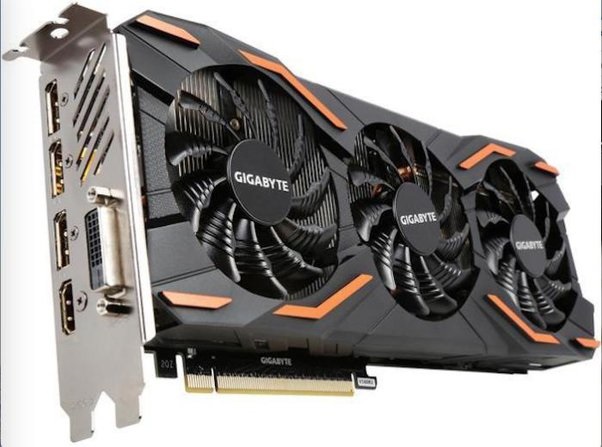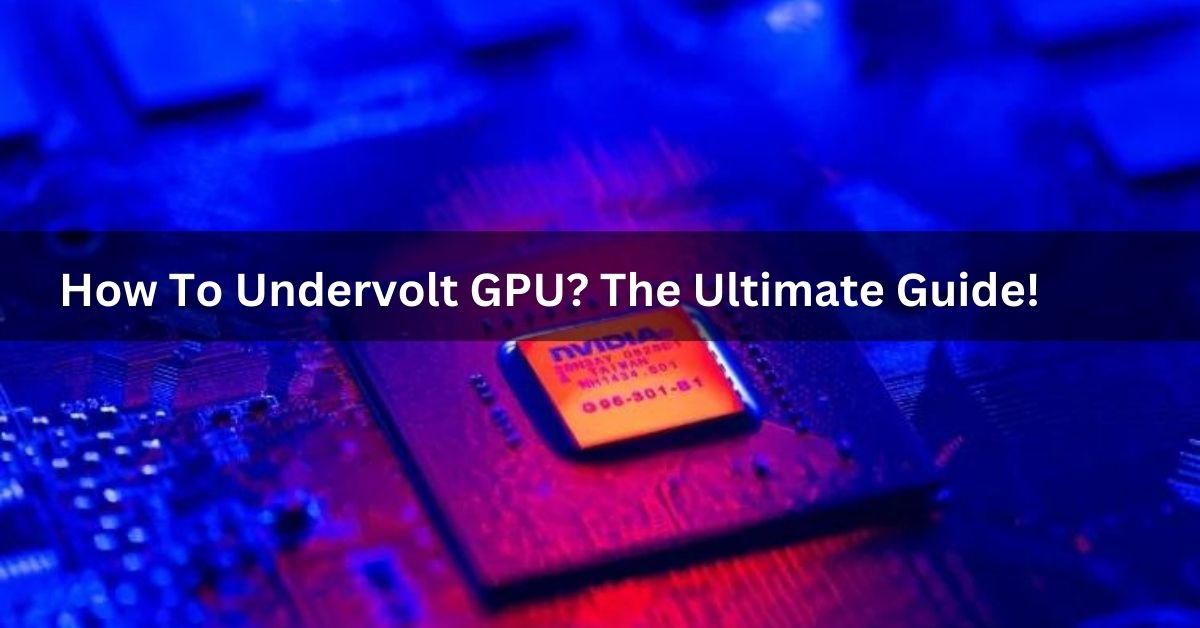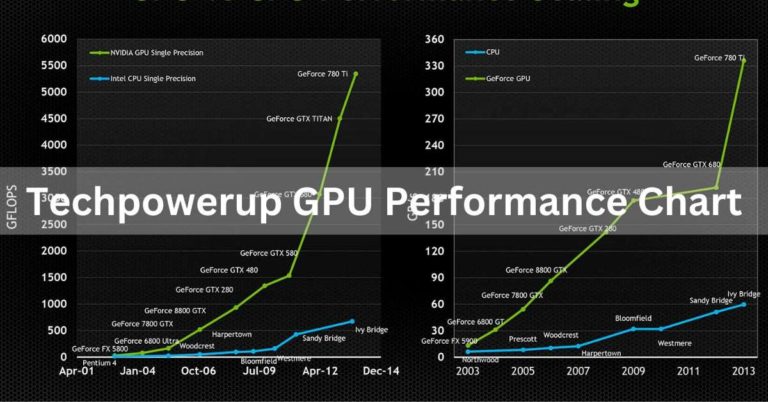How To Undervolt GPU? The Ultimate Guide!
GPU undervolting is a technique that allows you to optimize the power consumption and performance of your graphics card. By reducing the voltage supplied to the GPU, you can potentially decrease heat generation, energy usage, and even increase the overall lifespan of your GPU.
To undervolt a GPU, use software like MSI Afterburner or AMD Watt Man to reduce the voltage supplied to the graphics card, lowering power consumption and heat while maintaining stable performance.
In this article, we will guide you through the process of undervolting your GPU, providing you with the tools, knowledge you need to do it safely and effectively.
Understanding Undervolting:
Undervolting is the process of lowering the voltage supplied to your GPU, which results in reduced power consumption.
Voltage plays a crucial role in the performance of your graphics card, as it directly impacts the power it draws and the heat it generates during operation.
How to Undervolt Your Graphics Card:
To undervolt your graphics card, use software like MSI Afterburner. Gradually reduce voltage in small increments while testing stability. Find the lowest stable voltage for optimal performance with lower heat and power consumption.
How to tell if Monitor is dying?
To determine if a monitor is dying, look for signs such as flickering, color distortion, pixelation, or sudden blackouts. Check for unusual noises, monitor not powering on, or persistent issues after troubleshooting. If problems persist, it may indicate hardware failure, signaling the monitor’s decline.
Why Undervolt Your GPU?

1. Lower Power Consumption:
Undervolting your GPU can significantly reduce the power it consumes. This is especially important for gamers and cryptocurrency miners who want to lower their electricity bills.
2. Reduced Heat Generation:
By lowering the voltage, you also reduce the heat generated by your GPU. This can help maintain lower temperatures and prevent thermal throttling, resulting in more consistent performance.
3. Improved Stability and Longevity:
Undervolting can lead to a more stable system. It can also extend the lifespan of your GPU by reducing the stress on its components.
Undervolting Process:
Undervolting your GPU involves adjusting its voltage settings. It’s a delicate process that requires careful attention to detail. Here’s a step-by-step guide:
1. Install Undervolting Software:
Download and install the software of your choice for GPU undervolting.
2. Backup Your Settings:
Before making any changes, create a backup of your current GPU settings in case you need to revert.
3. Adjust Voltage Curve:
Use the software to modify the voltage-frequency curve of your GPU. Decrease the voltage while maintaining stable performance.
4. Test and Benchmark:
After each adjustment, run benchmarks or test your GPU’s performance in games to ensure stability.
5. Fine-Tune:
Continue adjusting the voltage curve until you find the optimal settings for your GPU.
Common Undervolting Issues:

While undervolting is generally safe, issues can arise. If you encounter problems like crashes or artifacts, it’s essential to troubleshoot and identify the root cause. If necessary, you can always restore your GPU to its default settings.
Why Should You Undervolt Your Graphics Card?
Undervolting your graphics card can reduce power consumption and heat generation, leading to improved energy efficiency and potentially longer hardware lifespan.
It can also help stabilize GPU performance and reduce fan noise, making it a useful optimization for both gamers and those concerned about power usage and heat management.
Is it good or bad to undervolt GPU?
Undervolting a GPU can be good as it reduces power consumption, heat, and potentially noise, without sacrificing much performance. However, it requires careful testing to find the optimal balance, as excessive undervolting may lead to instability or reduced performance.
What Does GPU Undervolting Do?
GPU undervolting reduces the voltage supplied to the graphics processing unit (GPU) while maintaining stable performance.
This results in lower power consumption, reduced heat output, and potentially longer hardware life. It can also lead to quieter fan operation and improved energy efficiency for laptops and desktop systems.
How to Undervolt a GPU With MSI Afterburner?
- Install MSI Afterburner and launch it.
- Click “Settings” and enable “Unlock voltage control” and “Unlock voltage monitoring.”
- Adjust the voltage slider to reduce voltage while testing for GPU stability.
- Apply settings and monitor performance to ensure stability without overheating.
Undervolting AMD GPUs:
Undervolting AMD GPUs involves adjusting the voltage to operate at a lower level, reducing power consumption and heat. Use software like Radeon WattMan for gradual adjustments, finding an optimal balance between performance, temperature, and power efficiency for your specific GPU model.
Also read: What Is The PS5 Gpu Equivalent? Learn Now!
How to undervolt an Nvidia graphics card?

To undervolt an Nvidia graphics card, follow these general steps:
1. Download Software:
Get software like MSI Afterburner or Nvidia Inspector to undervolt your GPU.
2. Install and Launch:
Install the software and open it.
3. Voltage Control:
Enable voltage control and monitoring in the settings.
4. Adjust Voltage:
Reduce the voltage incrementally (e.g., -25mV) and apply the settings.
5. Stress Testing:
Test your GPU’s stability by running demanding games or benchmarks.
6. Gradual Adjustments:
If stable, continue to lower the voltage until instability occurs. If instability happens, raise the voltage slightly.
7. Apply Final Settings:
Once you find a stable undervolt, apply those settings and test under different workloads to ensure stability.
Undervolting Guide:
Undervolting is a process of lowering the voltage supplied to a component, often a CPU or GPU, to enhance efficiency and reduce heat. Use dedicated software, like MSI Afterburner for GPUs, to make gradual adjustments, testing for stability.
Find the lowest stable voltage for improved energy efficiency without sacrificing performance. Always monitor temperatures and test system stability after undervolting.
Things To Do Before Undervolting Your GPU?
Before undervolting your GPU, ensure you have updated your graphics drivers to the latest version. Research your specific GPU model and undervolting process, as it may vary.
Backup important data in case of unexpected issues. Monitor temperatures and stability during the undervolting process to prevent potential performance issues or crashes.
A Step-by-Step Guide to Undervolt Your GPU:
- Choose the Right Software: Select a GPU tweaking tool such as MSI Afterburner or AMD WattMan.
- Monitor Baseline Performance: Note your GPU’s default settings and performance to compare later.
- Incremental Adjustments: Gradually decrease voltage in small increments (e.g., -10mV).
- Stress Testing: Run demanding applications or benchmarks to ensure stability after each adjustment.
- Monitor Temperatures: Keep an eye on GPU temperatures; undervolting should reduce heat.
- Optimal Balance: Find the lowest stable voltage that maintains performance without crashes or artifacts.
- Finalize Settings: Apply the optimal undervolt settings and test over time for stability.
- Enjoy Efficiency: Experience reduced power consumption, heat, and potentially quieter operation without sacrificing performance.
How to undervolt an AMD graphics card?
To undervolt an AMD graphics card, use software like AMD Radeon WattMan or MSI Afterburner. Reduce the voltage while maintaining stable performance.
Start with a small reduction and gradually decrease voltage until stability is compromised. This lowers power consumption and temperature while maintaining good GPU performance.
Also read: Pytorch Check If GPU Is Available? Complete Guide!
How to Undervolt GPU and Lower Temperatures?

To undervolt a GPU and reduce temperatures, use software like MSI Afterburner or AMD Radeon Wattman to decrease the voltage supplied to the GPU while maintaining performance.
This minimizes heat generation, resulting in lower temperatures and potentially extending the GPU’s lifespan.
How to Undervolt a GPU to Lower Temps and Reduce Power Usage?
- Select Software: Use tools like MSI Afterburner or AMD WattMan for GPU adjustments.
- Baseline Measurements: Record default temperatures and power usage to compare later.
- Gradual Undervolting: Decrease voltage in small steps, testing stability and performance after each adjustment.
- Stress Testing: Run demanding tasks or benchmarks to ensure the GPU remains stable.
- Monitor Temperatures: Check for temperature reductions, a key benefit of undervolting.
- Find Optimal Balance: Locate the lowest stable voltage that maintains performance without compromising stability.
- Apply Settings: Implement the optimal undervolt settings for long-term use.
- Enjoy Benefits: Experience lower temperatures, reduced power consumption, and potential noise reduction while maintaining GPU performance.
Why you should (or shouldn’t) undervolt your GPU?
Undervolting your GPU is beneficial because it reduces power consumption, heat, and potentially noise without sacrificing much performance.
However, it may not be suitable for everyone as improper undervolting can lead to instability or performance loss. Testing and monitoring are crucial to determine if the benefits outweigh potential drawbacks.
Frequently Asked Questions:
1. A Guide to Overclock and Undervolt your GPU?
To overclock your GPU, increase its clock speed and memory settings for better performance. Undervolting reduces power consumption and heat, extending GPU life. Use software like MSI Afterburner for adjustments.
2. How to Undervolt Your Graphics Card to Run Quieter and Last Longer?
To undervolt your graphics card, use software like MSI Afterburner or your GPU manufacturer’s tool to lower voltage settings, reducing heat and noise while extending the card’s lifespan.
3. What are the risks of undervolting my GPU?
Undervolting a GPU can lead to stability issues like crashes or artifacts if not done correctly. It may also result in reduced performance in some cases.
4. Can undervolting void my GPU warranty?
Undervolting typically doesn’t void your GPU warranty as it’s a reversible and non-invasive process. However, check your manufacturer’s policy to be certain.
5. Does undervolting affect gaming performance?
Undervolting can affect gaming performance, often in a negative way, as it may lead to lower clock speeds and reduced GPU power. However, it can vary depending on the specific GPU and settings used.
6. How often should I recheck my undervolting settings?
You should periodically recheck undervolting settings, especially after GPU driver updates or hardware changes. Regular checks ensure stability and optimal performance.
7. Are there GPUs that cannot be undervolted?
Most modern GPUs can be undervolted to some extent, but the degree to which you can undervolt may vary. Some GPUs have locked voltage limits or limited undervolting potential due to their design.
FINAL WORDS:
Underolting your GPU is a valuable technique to optimize power consumption, reduce heat, and potentially extend the lifespan of your graphics card. It’s a careful process, but with the right software and patience, you can enjoy improved energy efficiency and more stable performance. Just remember to periodically review your settings and test for stability. Undervolting is a reversible, non-invasive method, and it’s worth exploring to benefit both gamers and those concerned about power usage and heat management.







